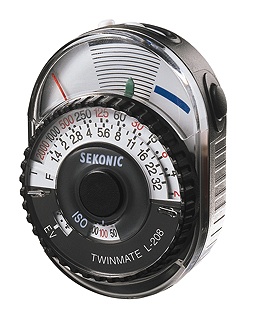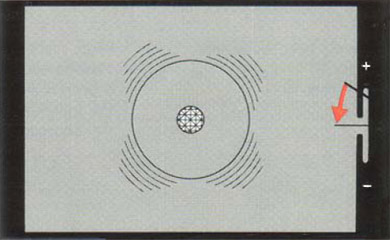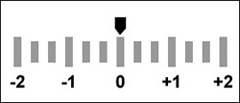We have discussed about film sensibility, shutter speed and aperture, all of which will have a different effect on how our image will be. But now, if we are using light and we are using all those parameters, for whichever reason, how do we know how many light is the right amount. Well, said in greater words, ISO is going to be the one who decides, but photographers will not talk about lumens or luxes (units for measuring light) but instead of that, they will explain everything with shutter speeds and aperture values. If you are a digital photographer in the making, do not use ISO Auto, as this will not let you advance. Film photographers, well, ISO can not be changed in the whole thing, so do not worry about that.
But before we continue on, we need to know how we measure our source material, light. So there are essentially two ways for doing so. Incident or reflected, one is more accurate than the other, but in the other hand the other is more practical. Lets go in parts.
Incident light
As far as mankind knows, light travels trough space but it tends to dissipate, and we can see this phenomena in just any lamp, as we put it higher it will draw a bigger circle but its "power" to illuminate will diminish, this happens because light travels in any directions, and sum to that the fact that there is also air, that has particles floating in it. Where are we going with this, that depending on how far the light source is, the intensity of it will be different. In the case of natural light, the Sun, it is a little bit irrelevant, but with artificial sources this is the most important consideration.
In this case of light metering, what you are going to buy is a hand expose meter, the most basic of this devices will have a light sensitive zone. Older models, had the look of an old voltmeter, as they used selenium, an compound that exposed to light will generate a voltage, so depending on the quantity of light the voltage will vary.
Many of this expose meters, you just set the dial in which the green and the red lines were one over the other, and then read the combination below. As you can see, it has a speed and an aperture scales, so when you made both were aligned, you were able to choose, ƒ 8 @ 1/60 (using the image as reference) but you also get something called, equivalent measures, we will discuss that later.
Most modern light meters are digital now, and most of them have at least three basic functions, ambient light, flash and flash with cord. The ambient light, well, may seem obvious but is when we are going to meter, continuous sources of light, like the sun or light bulbs. The other two functions will depend, in one, the device, will be waiting for the flash to fire and then measure, and the one with the cord, the apparatus is connected directly to the flashes and send the signal so it fires them.
In both, analogue or digital, we need to face the light sensitive part to the light source. As we are using a device solely to meter, this is why is the most accurate way of getting the exposure value, aperture and speed, on one ISO sensibility.
The downside of all of this, is that you have to buy an extra, that the cheapest are between $150-$200 USD, new, as always you can go to flea markets, swap meets, and so and maybe have luck and find one in great conditions. But do not fear my fellow readers, since a long time camera manufactures had come with a nice solution.
Reflective light
Last method worked by recieving light directly from the source, this one will work differently, and works just like our eyes do. We see because light is reflected from the objects, white light contains all the colors within it, we see the colors of things because they absorb the other colors and reflects the color they are. Inspired on this way of metering light, cameras from the 70's and on, were manufactured with an expose meter integrated with them. Some were like a crystal thing with bubbles attached to the camera, but other were more advance and the term TTL became famous, this means Trough The Lens, this meant that the light that passed trough the lens made the measure. This kind of metering was so accepted, because the expose meter was showed in the viewfinder, mostly in SLR's, so the photographer has a fast glimpse if it need more or less light for his/her shot.
Depending on how old and brand the camera is, the expose meter is displayed in different ways, some are very simple while others are quite trouble some. The most commons are like this:
In this case of expose meters, there is a needle, a plus a minus sign, and the middle mark, if the moving needle is charge to the minus, it means that your original settings are not letting enough light to pass, just compensate with speed or aperture letting more light pass (just move one, do not move the two freely), do this until, the needle stays very close the the middle mark. Doing so, we are going to have a well exposed photo, if the needle is in the less zone this means that our photograph is going to be underexposed, meaning that we let pass less amount of light that the one needed. This will lead to dark pictures with textureless darks and grey whites. In the other hand, leant to the plus side, we will end with an overexposed image, this will make that our blacks will not be blacks and our whites will not have textures. But as a safety for each photo it is better to be slightly overexpose, doing so we are going to force to the negative to receive information, that latter will be visible in the print.
There are other kinds of displays, there is one just with the plus, the minus and a dot. In this case each sing will shine, and when the dot shines the exposure is right. But there are some that are not as easy to get, there are some without lesses and pluses, some Minoltas used to have some like this:
In this case of exposure meters the needle in function of the aperture selected will move to the most suitable speed, at the beginning is a little bit confusing, but it all depends when both, speed meets the aperture, in this kind of expose meters, at the start, is hard to tell when is over or under exposed.
Newer expose meters are more like a ruler, with a mid-point, less or plus, but showed in steps, and some in half or thirds of a step. Canon and Nikon have something like this:
But this way of metering is not fool proof, it will depend highly on the lens mounted, how big is the metering zone inside the camera, or in modern cameras, how many metering dots has and the most important of all, it uses reflected light and not everything reflects the same amount of light, a white cup compared to a black one, the light one reflects more light than the darker one, and so we could end with a failed metering. In the next to images this is going to be demonstrated.
 |
| When you meter over something bright, like the white cup, the camera thinks is overexposed, and tells you that you need less light, resulting in an underexposed image, also se how white became gray. |
But do not fear, there are ways to achieve the right measure, and is not with any fancy stuff, is even a little bit old in fact. All the cameras' expose meters are calibrated to something called Grey at 16% or medium gray. So if the camera is expecting to see this gray, why not to use something that has this reflectance, here is when the Grey Card comes to hand, this cards can be found in any photographic supply store, it is also wide used in digital photography (not precisely to measure but for Withe Balance). They come as just a cardboard card with a gray side or be more sophisticated like a cube, that also has white, black and shiny things, more oriented to digital photography.
 |
| The grey card was just showed, and compare it with the previous image, in which we do not need to show it to have a nice photograph. |
To use the Grey Card we only need to put it in front of the lens, parallel to the lens front face and adjust speed or aperture so the meter is in the center, well expose, zone. Then we proceed to take the card of the sight of the lens and proceed to take the photograph. If we do not have a grey card at hand, our body has a part that reflects almost the same amount of light than a grey card, and is the palm of our hand, so we could put our hand in front of the lens, adjust the exposure so the meter stays in the zero zone, take the hand out of the zone and take our pic.








No comments:
Post a Comment